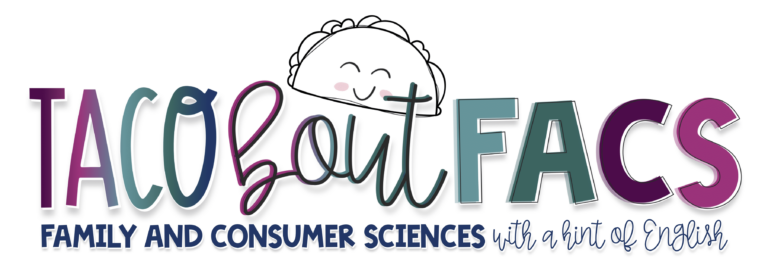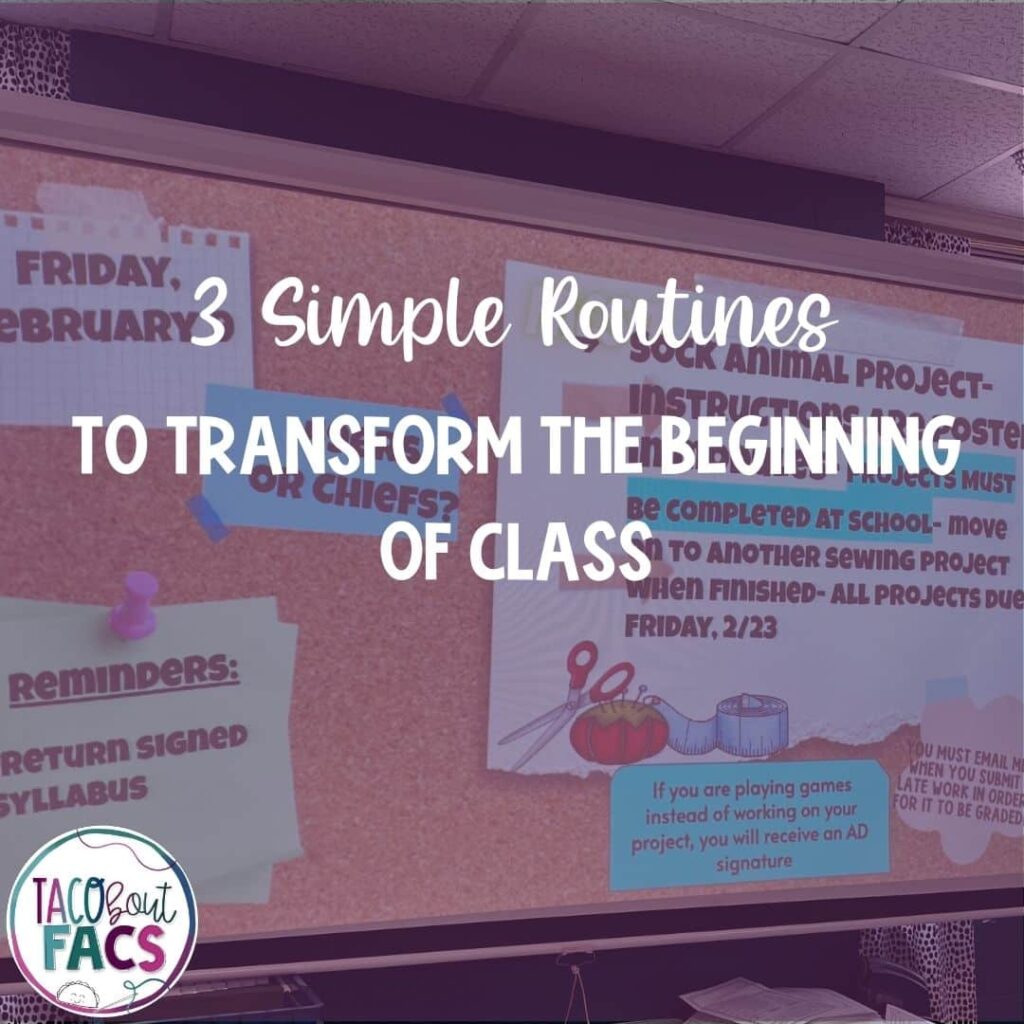Maybe you can relate?
Class begins and it appears the circus has arrived and everyone is performing at the same time?
I had taught 14 years before moving to the FACS classroom. 11 of those years in elementary and 3 in 8th grade English. If I could pull a strength from that era, it was my consistency and routine to start class during those 14 years.
In elementary, it was usually calendar math and in 8th grade English, it was bell work specific to the day of the week.
Moving to an elective class was eye-opening. Those same kids who had routine and structure in an English class down the hall were almost feral now that they were in an elective.
Consistent routines to start class
My building has 49 minute classes 4 days a week and 45 minute classes 1 day a week due to PLC meetings.
I find purpose and value in bell work, but ultimately found I needed more class time to get through my assignments and work time.
I do not assign homework in my elective class, simply because I have found projects that get completed at home, are usually completed by an adult. I am not here to grade an adult’s work. I wanted to maximize the amount of work time for my students and decided not to use bell work.
Instead, I have a “Daily Slide” on my projector screen. There is a slide for each day of the semester and I update this slide for the specific day.
Daily agenda slides
This “Daily Slide” gives all the information when students enter the classroom. I do have to train a few to read it first before asking the usual, “What are we doing today?”. Students know to look at this slide for everything they need to know during today’s class.

Students can scroll through the slides to find the specific day they missed class for more information. This also conveniently works as my lesson plans if I forgot to update my lesson plan document!
The “Daily Slide” is embedded at the bottom of my Canvas homepage so students can access the information outside of my classroom. This slide includes the important information needed for the day and students have a central location to look for the information. Here’s what I include on my “Daily Slide”:
- The date- seems simple, but there are times I accidentally scroll through to a different slide. It also allows absent students to see a specific slide.
- Daily attendance question- I have blogged about it before, you can read about it here. It builds relationships, it is a fun and engaging way to start class, and it helps you remember to take attendance. I cannot encourage you enough to start this routine in your classroom.
- It has the day’s agenda, due dates, and where to find more info (which is usually Canvas Modules).
- I also include reminders- such as return your signed syllabus or “You must email me when you submit late work since I do not receive late work notifications”.
- On days with a different bell schedule, I will add a box for the new schedule so I don’t have to answer the thousands of questions about what time the bell will ring.
I use Google Slides for my “Daily Slide”. By duplicating the previous day’s slide and putting the current day at the top of the slide list, the current day will be the first to show up when I embed the Slides on Canvas. Students can then scroll through to see previous days in the semester.
If you would like to use Slides in your class, you can purchase the resource here.
To avoid confusion, I create a new Slide per semester. It’s the same template, but does not include the Slides from the previous semester. I have found it is easier and faster to start all over each semester.
I keep this slide projected the entire class, unless I need to pull up a presentation, video, etc needed for the lesson. I always make sure to switch back to this slide at the end of class in preparation for the next class. I make sure to train students to check the date in case I projected the wrong slide.
Daily attendance question
I cannot shout from the rooftops enough, if your classroom needs routine, structure, relationship building, excitement, and the list goes on, then your classroom needs a daily attendance question.
Why does it work? It makes kids think, but in simple and silly ways. It breaks up the boring routine of a mundane task. It allows you to build connections and makes students feel seen.
How does it work? I waste no time. When the tardy bell rings, I am ready to start attendance within 1-2 minutes. It’s usually me waiting on PowerSchool to load. As I am closing the door after the tardy bell, I am usually announcing “Today’s daily attendance question is….” and then off we go.
It does take longer at the start of the semester to get through the names and getting an answer, but then it speeds up to 3-4 minutes. I can justify less than the first 5 minutes of class to build connections and relationships.

I always choose questions with an open-ended answer versus a yes/no answer. I do not accept “I don’t know” as an answer, but I would accept “I don’t watch football” when I recently asked “Chiefs, 49ers, or Usher?” for the Friday question before the Super Bowl.
Assigned seats
I know you are wondering how this one helps transforms your class, but it does.
I have a strict classroom expectation, which is also a building expectation. All students are seated, in their assigned seats, when the bell rings or else you are considered tardy.
When students feel they can wander and chat where ever at the start of class, it takes away from class time. It starts the class off on the wrong foot and students seem confused about what is expected.
Seated in your assigned seat before the tardy bell sets a clear tone you are ready to start class.
This does not just happen, I am still reminding students every single day, “You are seated before the bell rings!”
Creating seats charts is such a draining task. I am not opposed to allowing students an opportunity to choose seats, but most hours cannot seem to handle that privilege. For the hours that need a seating chart, I also have a plan and routine.
I have a Ziplock bag labeled for each hour and a popsicle stick for each student. To save sticks, which are like gold for projects, I flip them over and write the second semester name on the back when the time comes. I hang the Ziplock bag with a binder clip on a Command Hook near my desk.

Once I announced students change seats at the start of each unit, I have never needed to remember myself. I always have a student remind me when it is time to switch seats.
I draw sticks for new seats. We switch seats for each unit so it happens quite regularly during the semester. There is complete randomness when pulling sticks. Sometimes it works in their favor and sometimes it works in mine because they aren’t with friends and the class stays rather quiet!
Of course, I can override any of the sticks and certainly have when I have ornery boys who cannot handle it.
I feel like seeing multiple seating charts helps me get to know which students might be able to work well together in the kitchen. Cooking happens during the last quarter of the semester. While I do give students the opportunity to choose cooking groups, I always start cooking labs by choosing groups for them.
I teach semester courses, which means always teaching and reteaching expectations. Implementing these daily routines does not mean overnight classroom management success. I can attest to the consistency of the same routines and expectations will bring success to your classroom.

